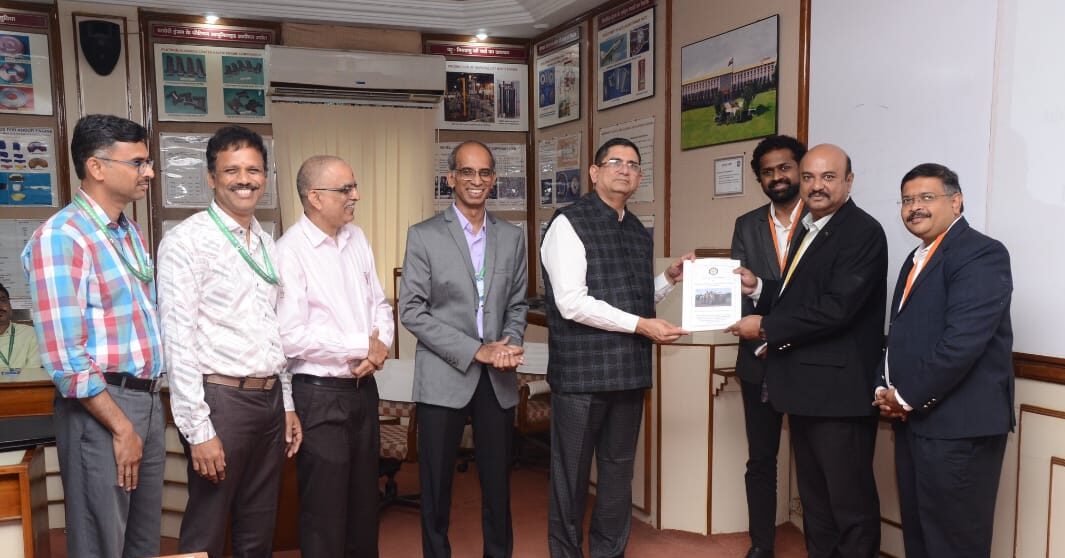Dr. Santanu Mandal, Head of R&D, Industrial Ceramics Division, CUMI, Subbu Venkatachalam, Head of Marketing, CUMI, and Rama Sundaram R, Senior General Manager, Marketing, Industrial Ceramics Division, CUMI during the award of the Transfer of Technology (ToT) from DMRL
The lightweight armour panels engineered with high-end technical ceramics will ensure superior mobility and outstanding protection of wheeled armoured platform vehicles.
The Defence Metallurgical Research Laboratory (DMRL) has signed a Transfer of Technology (ToT) to Carborundum Universal Limited (CUMI) to manufacture add-on composite armour for Wheeled Armoured Platform (WhAP) vehicles. The lightweight composite armour will reinforce combat vehicles providing all-round ballistic protection at STANAG Level II and III.
This ToT is a key milestone in India’s quest for indigenisation of advanced materials to build world-class armouring capabilities for highest protection of vehicles.
The WhAP 8×8, developed by the Defence Research & Development Organisation (DRDO), has been built with a global design philosophy. It can be adapted to fulfil diverse roles for the military since its design is modular, scalable, and can be easily reconfigured. As India’s first indigenously designed and built amphibious wheeled infantry combat vehicle, the 8X8 presents a significant opportunity for Indian manufacturers to contribute to India’s defence modernisation while augmenting export potential of military hardware.
Pioneering advanced and indigenously manufactured materials to protect armoured vehicles
CUMI’s indigenously manufactured elastomeric add-on armour composite panels with DRDO-DMRL technology are a pioneering innovation. The customised ceramic segments are sandwiched between rubber and backed up by a metallic mother plate which is impact-, UV- and weather-resistant. Each wheeled armoured platform will require a maximum of 300 unique ceramic armour panels, engineered to precisely contour the vehicle for highest levels of safety and ballistic protection. The segments are designed using high-end technical ceramic grade of CUMI’s Zirconia Toughened Alumina which has been thoroughly tested and qualified by DRDO-DMRL.
With 70 years of expertise in materials science engineering, CUMI is well-positioned to deliver advanced armour materials for defence applications. Over the years, CUMI, as a long-standing partner of DMRL, has been involved in cutting-edge innovations in materials that have helped design robust armouring solutions for military vehicles. Key priorities addressed include lightweighting, easy manoeuvrability regardless of terrain, improved ballistic protection through precision engineering, while being resistant to impact and extreme weather conditions. For instance, a key feature of the WhAP is superior mobility, to navigate through the toughest terrains on land and water with ease. This can be attributed to CUMI’s lightweight composite armour panels, crafted with advanced ceramics for exceptional protection with minimal increase in weight.
Expanded scope through materials science innovation for India and the world
The global market size for armoured vehicles is forecast to expand from $23.73 billion in 2024 to $37.85 billion by 2032. The global market for advanced materials is growing in parallel to meet evolving security threats. It is projected to touch $10.10 billion by 2032, from $9.3 billion by 2029 and $6.7 billion in 2024.
By making significant investments in R&D and capacity expansion, materials science-led companies like CUMI have been gearing up to ably fulfill domestic requirements while also contributing to realise India’s global ambitions. They are also helping to solve inherent sectoral challenges, especially in the area of critical materials by bridging supply gaps, reducing import dependence, and making cost-effective, globally-benchmarked materials available for OEMs to deploy the best in tech.
All these factors are not only enabling India’s Armed Forces march faster towards their goal of modernisation but also helping domestic players gain a wider market for their products and solutions worldwide.
In the long-term, this will help India to build strategic alliances across nations, consolidate its position as a global defence manufacturing hub and realise its defence exports ambition of INR 50,000 crores by 2028-29, ultimately leading to a stronger and more self-reliant nation.

